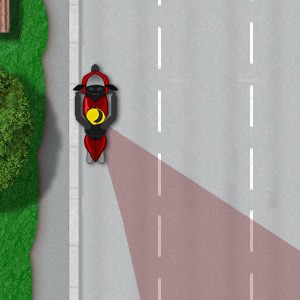Moving Off On a Motorcycle
Moving of on a motorcycle requires that you take your own safety into consideration and that of other road users and pedestrians
This tutorial provides an example of moving off on a motorcycle from a roadside parked position that would be acceptable for an examiner during a practical riding test. Get yourself ready to move off by following this procedure:
1. Sit astride your motorcycle
2. Start the engine. If you are unsure of this procedure, see starting a motorcycle engine
3. Fully squeeze in the clutch lever
4. Select first gear and ensure you keep the clutch lever fully squeezed in
5. Support the motorcycle with both feet and retract the kickstand
6. Now shift the weight of the motorcycle slightly to the left, put your right foot onto the footrest and apply the rear brake. The motorcycle is now prepared for moving off.

Safety Observations
It’s essential that you now perform safety observations before moving off. Check in front to ensure there are no pedestrians crossing the road or vehicles turning in front of you. To check behind, you may check in your rear view mirrors if you wish (if fitted to your motorbike), but it’s essential that you physically look round to ensure there are no vehicles or cyclists approaching from the rear.
Never rely on mirrors alone. There are certain areas in rear view mirrors that obscure rear observation, which is why you must look behind to check. For further information on these areas, see:
What to Look Out For
Whilst performing safety observations and checking behind, you should look for:
- Vehicles, cyclist and pedestrians
- Cyclists can be harder to see than larger vehicles such as cars
- Look out for pedestrians that may be crossing the road in front of you
- You will need to judge the speed of any vehicles or cyclists approaching from behind accurately before moving off. If in doubt, wait.
If it is all clear, you can release the brakes and gently apply the throttle to move off. If you have performed your rear observations and have decided to wait for vehicles to pass, remember to check again behind you before moving off.
Indicating Before Moving Off
Indicating / signalling is required when moving off if this helps others to become aware of your intentions. This includes road users on the opposite carriageway and if there are pedestrians close by. Failing to signal where it may impact other road users or pedestrians may fail a riding test.
It is not mandatory during a riding test to signal whilst moving off if there is no one around to benefit. In this situation, you may or may not signal, it’s simply up to you, though it may be of benefit to signal regardless so as it becomes habit. Remember to cancel your signal as soon as you have moved off as this may cause confusion to other road users.
Motorcycle Angle Start
Once you have practiced moving off, you’ll need to start with moving off at an angle. This is where you move off from a stationary position from the left-side of the road from behind a parked car. See
Motorcycle Hill Start
The module 2 riding test (on-road) will involve the examiner requesting another moving off procedure – the hill start. The hill start tutorial offers a guide on how to move off on an uphill gradient.